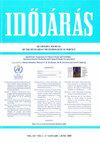Investigation and analysis of the Iranian autumn rainfall thickness pattern
IF 0.8
4区 地球科学
Q4 METEOROLOGY & ATMOSPHERIC SCIENCES
引用次数: 0
Abstract
The purpose of this study was to investigate and analyze the trend of autumn precipitation thickness pattern in Iran. For this purpose, two environmental and atmospheric databases have been used. Environmental data is prepared and networked in two stages, in the first stage with the help of 1434 stations and in the second stage with the help of 1061 stations. Atmospheric data includes geopotential height data obtained from the National Center for Environmental Prediction and the National Center for Atmospheric Research (NCEP / NCAR). The spatial resolution of this data is 2.5 × 2.5 degrees. The thickness of the atmosphere, which is usually between 500 and 1000 hectopascals, is shown. This thickness is considered as the thickness of the whole atmosphere. The results of the autumn precipitation trend showed that although autumn precipitation on monthly and annual scales has experienced an increasing trend in most regions, in less than 5% of Iran, the upward trend has been significant. The most intense upward trend is observed in the form of spots in the central and northern parts of the Zagros Mountain, while the greatest decreasing trend has been observed in the form of cores along the Caspian coastal cities. The results of the autumn precipitation thickness pattern showed that the autumn precipitation thickness pattern is affected by deflection and instability due to high latitude cold and humid weather and low latitude hot and humid weather occurred in North Africa, in such a way that the Black Sea and the Mediterranean Sea provide the required moisture in high latitudes and the Red Sea and the Persian Gulf in low latitudes.伊朗秋季降水厚度格局的调查与分析
本研究的目的是调查和分析伊朗秋季降水厚度格局的变化趋势。为此目的,使用了两个环境和大气数据库。环境数据的准备和联网分两个阶段,第一阶段有1434个站点的帮助,第二阶段有1061个站点的帮助。大气数据包括从国家环境预测中心和国家大气研究中心(NCEP / NCAR)获得的位势高度数据。该数据的空间分辨率为2.5 × 2.5度。大气的厚度通常在500至1000百帕斯卡之间,如图所示。这个厚度被认为是整个大气的厚度。秋季降水趋势分析结果表明,虽然大部分地区的秋季降水在月和年尺度上都有增加的趋势,但伊朗不到5%的地区的秋季降水上升趋势显著。Zagros山中部和北部的斑点形式的上升趋势最强烈,而里海沿岸城市的岩心形式的下降趋势最大。秋季降水厚度型的结果表明,秋季降水厚度型受高纬度寒湿天气和北非低纬度湿热天气引起的偏转和不稳定的影响,使得黑海和地中海在高纬度地区提供所需的水分,而红海和波斯湾在低纬度地区提供所需的水分。
本文章由计算机程序翻译,如有差异,请以英文原文为准。
求助全文
约1分钟内获得全文
求助全文
来源期刊

Idojaras
地学-气象与大气科学
CiteScore
1.60
自引率
11.10%
发文量
9
审稿时长
>12 weeks
期刊介绍:
Information not localized
 求助内容:
求助内容: 应助结果提醒方式:
应助结果提醒方式:


